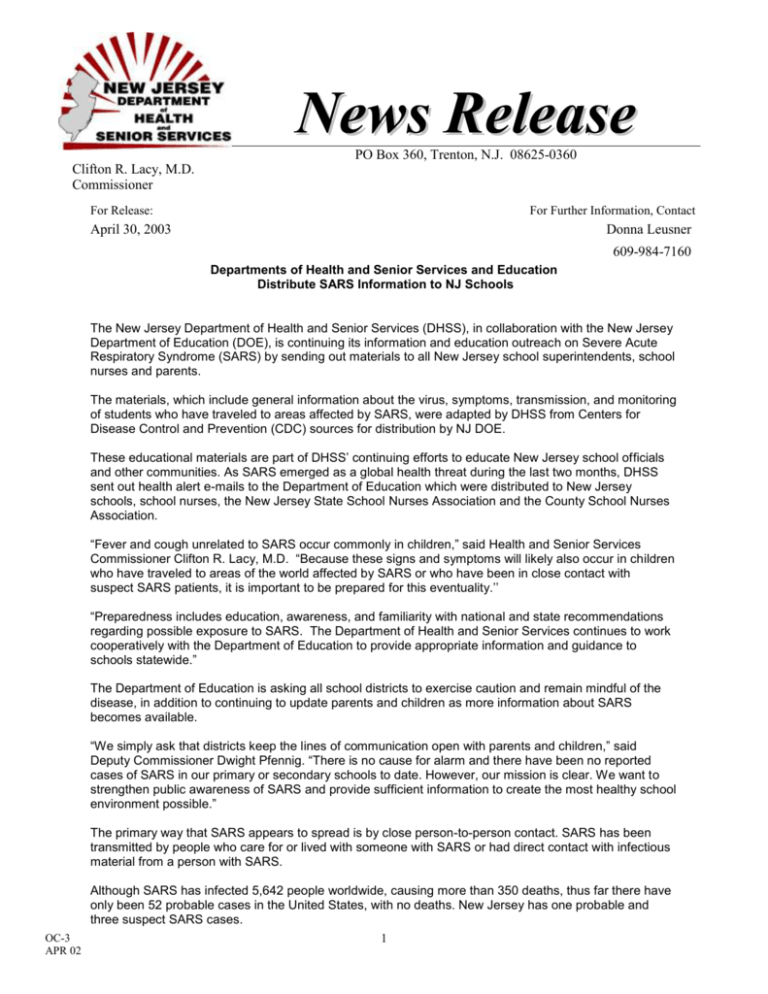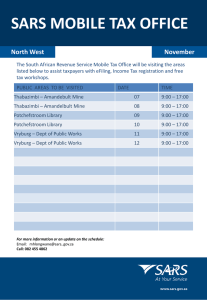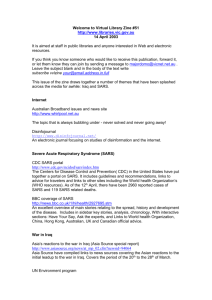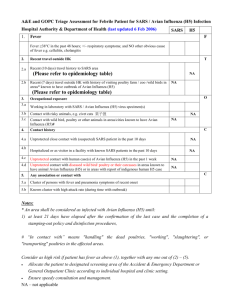News Release
advertisement

News Release PO Box 360, Trenton, N.J. 08625-0360 Clifton R. Lacy, M.D. Commissioner For Release: For Further Information, Contact April 30, 2003 Donna Leusner 609-984-7160 Departments of Health and Senior Services and Education Distribute SARS Information to NJ Schools The New Jersey Department of Health and Senior Services (DHSS), in collaboration with the New Jersey Department of Education (DOE), is continuing its information and education outreach on Severe Acute Respiratory Syndrome (SARS) by sending out materials to all New Jersey school superintendents, school nurses and parents. The materials, which include general information about the virus, symptoms, transmission, and monitoring of students who have traveled to areas affected by SARS, were adapted by DHSS from Centers for Disease Control and Prevention (CDC) sources for distribution by NJ DOE. These educational materials are part of DHSS’ continuing efforts to educate New Jersey school officials and other communities. As SARS emerged as a global health threat during the last two months, DHSS sent out health alert e-mails to the Department of Education which were distributed to New Jersey schools, school nurses, the New Jersey State School Nurses Association and the County School Nurses Association. “Fever and cough unrelated to SARS occur commonly in children,” said Health and Senior Services Commissioner Clifton R. Lacy, M.D. “Because these signs and symptoms will likely also occur in children who have traveled to areas of the world affected by SARS or who have been in close contact with suspect SARS patients, it is important to be prepared for this eventuality.’’ “Preparedness includes education, awareness, and familiarity with national and state recommendations regarding possible exposure to SARS. The Department of Health and Senior Services continues to work cooperatively with the Department of Education to provide appropriate information and guidance to schools statewide.” The Department of Education is asking all school districts to exercise caution and remain mindful of the disease, in addition to continuing to update parents and children as more information about SARS becomes available. “We simply ask that districts keep the lines of communication open with parents and children,” said Deputy Commissioner Dwight Pfennig. “There is no cause for alarm and there have been no reported cases of SARS in our primary or secondary schools to date. However, our mission is clear. We want to strengthen public awareness of SARS and provide sufficient information to create the most healthy school environment possible.” The primary way that SARS appears to spread is by close person-to-person contact. SARS has been transmitted by people who care for or lived with someone with SARS or had direct contact with infectious material from a person with SARS. Although SARS has infected 5,642 people worldwide, causing more than 350 deaths, thus far there have only been 52 probable cases in the United States, with no deaths. New Jersey has one probable and three suspect SARS cases. OC-3 APR 02 1 Included below are the CDC guidelines and recommendations for management of school students exposed to SARS: Interim Domestic Guidance for Management of School Students Exposed to Severe Acute Respiratory Syndrome (SARS) To date, all reported patients with Severe Acute Respiratory Syndrome (SARS) in the United States have been exposed either through previous foreign travel to countries with community transmission of SARS or close contact (e.g., household members or healthcare workers) with SARS patients; an updated list of areas with documented or suspected community transmission of SARS, can be found at the case definition page. Casual contact with a SARS patient at schools, other institutions, or public gatherings (e.g., attending the same class or public gathering) has not resulted in reported transmission in the United States. However, management of students exposed (i.e., through foreign travel or close contact) to SARS patients is a concern. The following are interim recommendations concerning management of exposed students. 1. Exposed students who develop fever or respiratory symptoms (e.g., symptomatic exposed student) during the 10 days following exposure should avoid contact with others, seek immediate medical evaluation, and practice infection control precautions recommended for SARS patients in the home or residential setting. Symptomatic exposed students should not go to school or work, but should stay home while arranging healthcare evaluation; in advance of the evaluation, healthcare providers should be informed that the individual may be developing SARS. 2. If symptoms do not progress to meet the suspect SARS case definition within 72 hours after first symptom onset, the student may be allowed to return to school or work, and infection control precautions can be discontinued. 3. For students who go on to meet the case definition for suspected SARS (e.g., develop fever and respiratory symptoms), infection control precautions should be continued until 10 days after the resolution of fever, provided respiratory symptoms are absent or improving. Suspected SARS should be reported to local health authorities, school officials, and other healthcare providers immediately. 4. If a symptomatic exposed student lives in a residence where appropriate infection control precautions cannot be implemented and maintained (e.g., crowded dormitory setting), alternative housing arrangements should be made. If there is no such alternative, the student should be hospitalized, or housed in a designated residential facility for convalescing SARS patients, where infection control precautions can be followed. 5. Exposed students without fever or respiratory symptoms should not be excluded from school; however, these individuals should be vigilant for onset of illness, and the exposure should be reported to the appropriate points of contact (e.g., school officials and local health authorities). 6. In a school which has a symptomatic exposed student enrolled during the 10 days following exposure, education concerning the symptoms of SARS and monitoring of potentially exposed students and school personnel should be conducted in consultation with the local health department. “We are recommending that students who have traveled to areas affected by SARS who do not have fever or respiratory symptoms continue to attend school,” said State Epidemiologist Eddy Bresnitz, M.D. OC-3 APR 02 2 “However these students and their parents should be vigilant for onset of illness, and their travel history should be reported to the appropriate school and local health authorities.” SARS is a respiratory illness that has recently been reported in Asia, North America, and Europe. The illness usually begins with fever greater than 100.4ºF. The fever is sometimes associated with chills or other symptoms, including headache, general feeling of discomfort and body aches. Some people also experience mild respiratory symptoms at the outset. After 2 to 7 days, SARS patients may develop cough that might be accompanied by or progress to the point where there is not enough oxygen getting to the blood. Scientists at CDC and other laboratories have detected a previously unrecognized strain of coronavirus virus in patients with SARS. The new coronavirus is the leading microorganism suspected to cause SARS. However, other viruses are still under investigation as possible causes. As SARS emerged as a global health threat, DHSS implemented an aggressive and comprehensive information campaign. Department educational initiatives have included: Weekly teleconferences with New Jersey hospitals and public health agencies to provide updates, explain how to identify potential cases, and detail appropriate reporting mechanisms. Transportation guidelines disseminated by e-mail to the state's 30 advanced life-support programs, the state’s 155 basic life-support programs and New Jersey’s hospitals and public health agencies. Fact sheets on SARS are available in Chinese, Vietnamese, Korean, Spanish, Japanese and French on the DHSS website at www.state.nj.us/health. #### OC-3 APR 02 3





